Rising patient volumes and staffing challenges: 7 takeaways from a new salary survey of radiologists, techs and administrators
Hiring challenges, swelling patient volumes and burnout continue to impact individuals at all levels of the imaging team, according to new survey data gathered by Radiology Business.
Across all titles surveyed—including radiologists, administrators and technologists—the top three biggest challenges in the specialty remained unchanged from our 2022 report. “Increased workload due to organizational changes” was the concern cited by most imaging professionals (rising from No. 2 in 2022). “Overall staffing levels” clocked in at second (it was No. 1 previously), while “patient volumes increased” remained at No. 3 year over year.

“We work with companies that source physicians to us for recruitment, and they’ve told us, in 20 years, they’ve never seen the market as competitive as it is right now for radiologists."
Maegan Moore, director of physician recruitment and onboarding at Essential Radiology in Charlotte, North Carolina
Amid frenzied competition for hiring, hospitals and practices are trying anything to attract radiologists: six-figure sign-on bonuses, flexible hours, months of vacation time and even immediate partnership tracks.
“We work with companies that source physicians to us for recruitment, and they’ve told us, in 20 years, they’ve never seen the market as competitive as it is right now for radiologists,” said Maegan Moore, director of physician recruitment and onboarding at Essential Radiology in Charlotte, North Carolina. “It’s incredible what the competition is right now.”
We gathered data for the 2023 Radiology Business Salary and Job Satisfaction Report earlier this year, reaching members of the imaging team via email.
Here are seven key takeaways.
1. Radiologist pay continues to rise
As competition for physician talent continues to heat up, compensation is rising along with it. U.S. radiologists earned an average gross annual salary of $481,660 in 2022, our survey found, up 13% from the figure recorded in our previous report. Factoring in other incentives, members of the specialty tallied total compensation of $589,505, including an average bonus of $107,845, survey respondents said.
Nearly half of radiologists polled said their compensation is based at least partially on performance, the most popular answer:

Cash was the most common form of additional compensation among the specialty (46.5%), followed by retirement pay (37.4%), profit-sharing (26.3%), or a sign-on bonus (7.1%). On average, radiologists said they earned about 32.6% of their potential performance bonus in 2022.
Competition is forcing practices to get creative in how they attract and compensate radiologists, said Tyler Burkle, senior director of recruiting at AMN Healthcare. Groups that were not open to work-from-home teleradiology arrangements are now testing the waters to lure physicians who want to lessen their commute times. Others are getting more creative with scheduling, allowing radiologists to work “swing shifts” where they might be on for seven days in a row and then off the two weeks that follow.
Burkle said he also has seen multiple practices entice new physicians with immediate partnership tracks, rather than asking them to wait several years before reaching this milestone.
“You need to be as flexible as possible, including creating a hybrid model where radiologists can work from home partially,” he said. “If you’re trying to attract candidates coming right from residency, we’re seeing groups and hospitals have a lot of success with offering a big student loan repayment package where, say, $200,000 is forgiven over the course of five years,” he added, estimating that only about 25% of groups are trying this approach.
2. Majority of professionals feel fairly compensated
Amid rising pay rates to attract and retain talent, the majority of those reached by our survey said they feel fairly compensated.
This included 66.7% across all titles, 63.2% among management—a category that included department chiefs, VP/service line directors, administrators, and office/business managers—and 60.4% among radiologists. Radiologic technologists recorded the lowest number, with 56.8% agreeing that they felt fairly compensated in 2022.
Our survey found that radiologic technologists earned average base gross annual compensation of about $85,463, up 4.6% from the figure recorded in our 2019 report. Techs said they earned average additional compensation last year of $7,502, most commonly coming in the form of a retirement bonus (35.6%) or cash (22.2%).
Asked if they would choose a different career path if given the chance to relaunch their career, the majority of respondents said they’d stick with the profession:
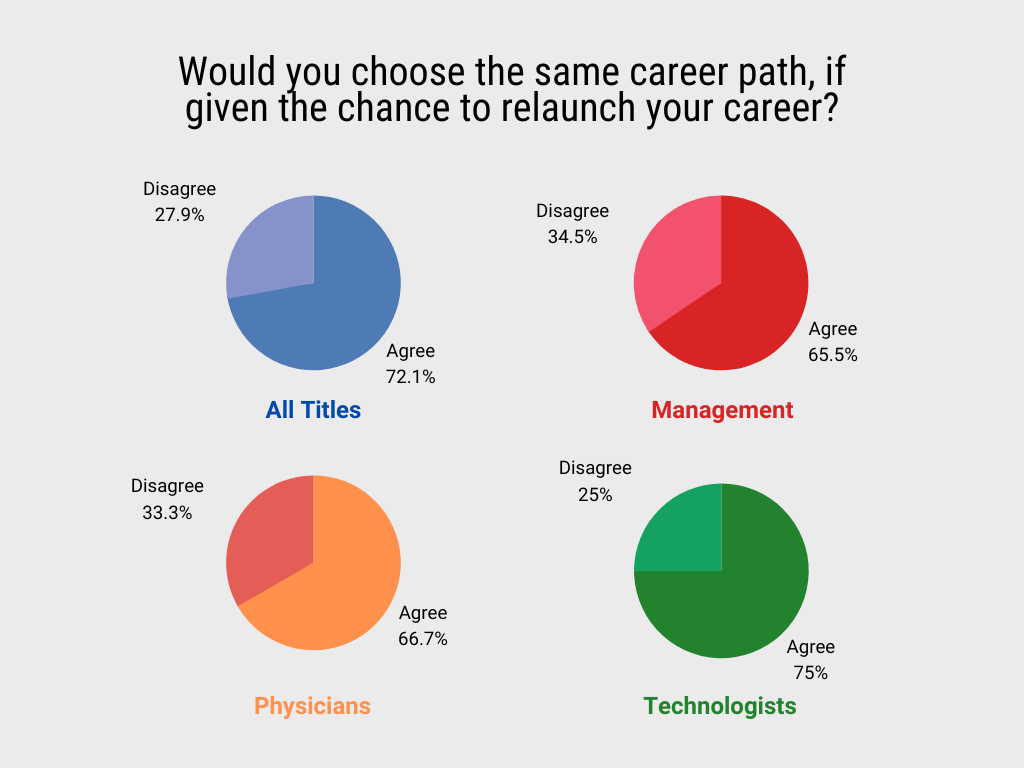
In addition, average annual salaries for other job titles included:
- Department chiefs: $344,448
- VP/service line directors: $ 177,731
- Administrators: $ 153,626 (up 19% from the figure recorded in our previous survey, though the number may be impacted by outliers/a low sample size)
- Office/business managers: $102,937
3. Many are planning to stay put
Content with their current compensation, and despite historic hiring demand, many also are staying put. Across all titles surveyed, 41.2% said they applied for a new job during the past year, while 58.8% said they did not.
Technologists recorded the highest number, with 52.3% saying they spent time applying to or considering a new employment opportunity, followed by 47.2% of imaging managers and 42.7% of physicians.
Within the next 12 months, a change of employers for me is:
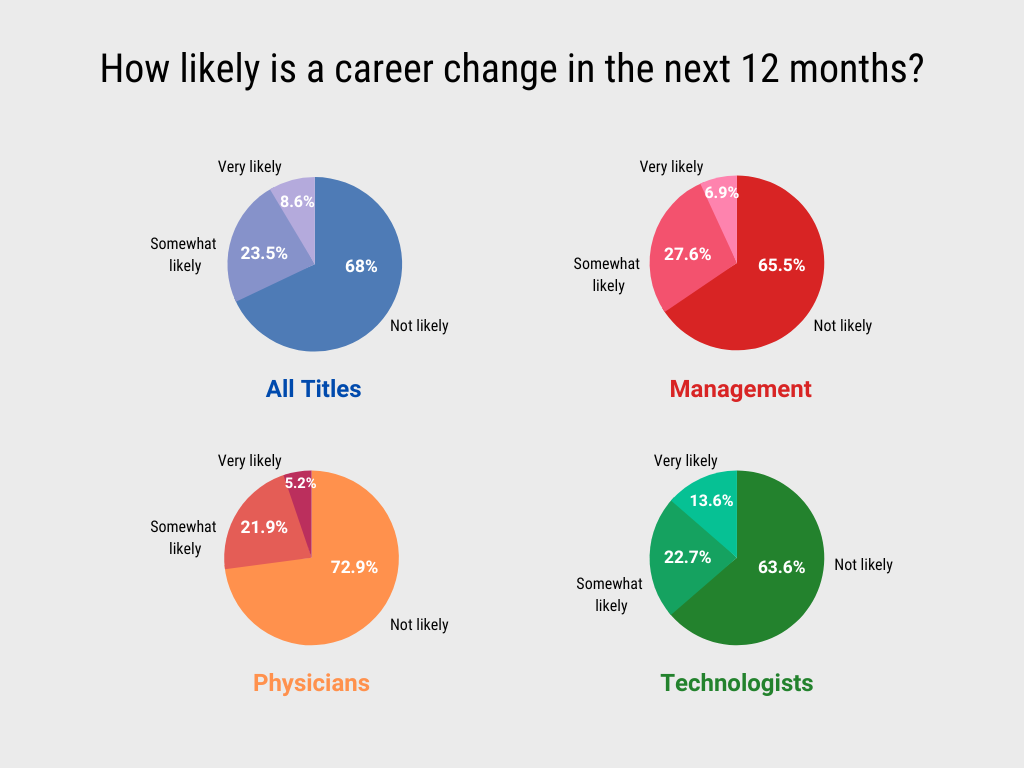
Shannon Noelle Wilson, the immediate past president of the Radiology Business Management Association, noted several factors that might be keeping professionals from switching organizations. Some states are seeing long backups in the process to apply for licensure. And it can take upward of six months to onboard a radiologist in 2023, whereas it was taking as few as 90 days in years past. Economic uncertainty and a challenging housing market are only complicating matters further.
“Some of the things that are frustrating for radiologists, and that they like to complain about, are the same everywhere,” said Wilson, who also is associate director of professional billing in radiology and radiation oncology at Mass General Brigham. “Jumping ship from one practice to another is not going to help you tremendously, and I think they realize that.”
“I think no one really wants to make a change. It’s very uncomfortable, especially if you’re packing up and moving across the country,” added AMN Healthcare’s Tyler Burkle. “Candidates aren’t necessarily actively looking at all times. But when circumstances change within their practice, that may force them to. Competition and the constant pressure of decreasing reimbursements are often causing candidates to keep an eye out for different options.”
4. All titles are feeling financial pressure in their organization
Across all titles surveyed, members of the radiology team are experiencing the weight of such monetary challenges, our survey found. Asked to pinpoint the greatest danger to their job security/satisfaction, “external financial pressure on our organization” was the No. 1 answer for radiologists, managers and techs.
The greatest threats to my job security/satisfaction are:
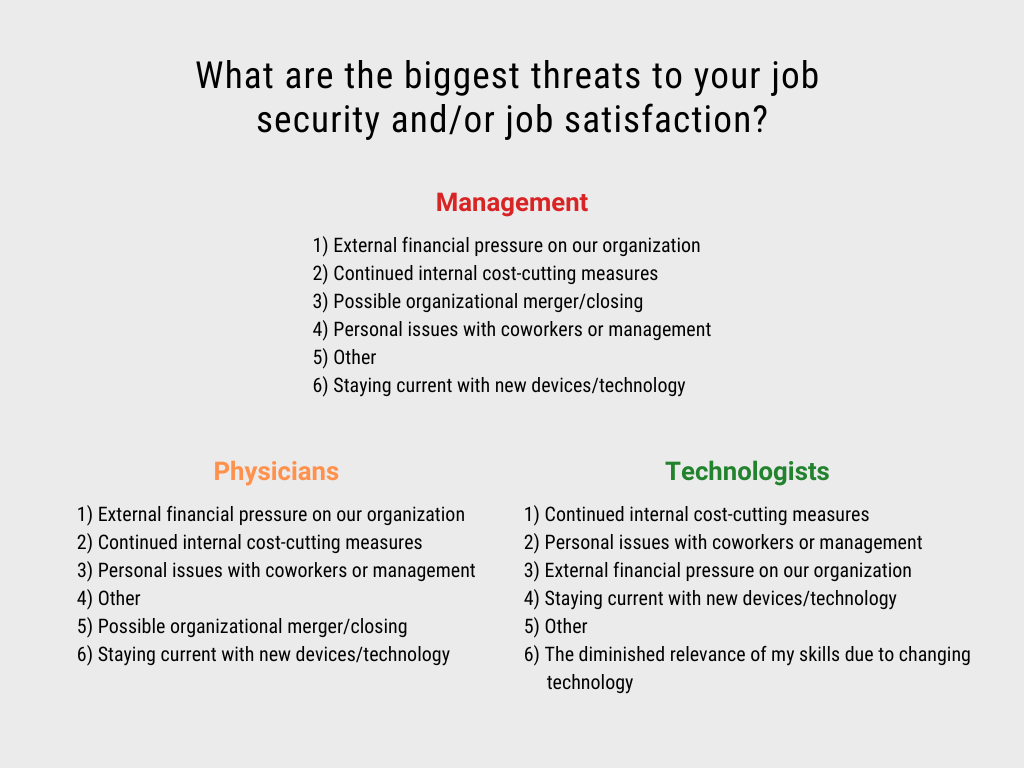
Consulting firm Vizient highlighted some of these pressures in a May 2023 report exploring the top trends shaping diagnostic imaging. Over 85% of outpatient facilities and hospitals are facing staffing challenges. At the same time, the U.S. Department of Labor is anticipating a 10% uptick in demand for staffing across MRI, nuclear medicine, ultrasound, radiologic and cardiovascular technologists, and medical dosimetrists. Burnout, longer lead times for filing roles, increasing merger activity, and higher sign-on bonuses further complicate the process.

“At the heart of the issue, you have increased patient demand; volumes are the same or growing, and they’re expected to continue doing so."
Adam Fairbourn Jr., Vizient’s Director of Contract Services
Adam Fairbourn Jr., Vizient’s director of contract services and one of the report’s co-authors, noted several trends impacting rad techs in particular. Turnover among the profession is estimated at 17.5%. Graduates taking the American Registry of Radiologic Technologists exam was down nearly 8% in 2020. And many aging members of the profession have moved toward retirement.
“At the heart of the issue, you have increased patient demand; volumes are the same or growing, and they’re expected to continue doing so. And at the same time, you’ve got an ongoing shortage of technologists and radiologists,” he said. “Whether it improves or not, I think providers will need to look at solutions to try and improve their capacity and workflow,” he added later, pointing to artificial intelligence as one key consideration.
5. Staffing levels, increased workloads remain top challenges
Like our 2022 report, overall staffing levels and increased workloads remain top challenges. Here is the breakdown among the three titles surveyed:
The biggest challenges I've faced so far this year are (Please choose at least three but no more than five):
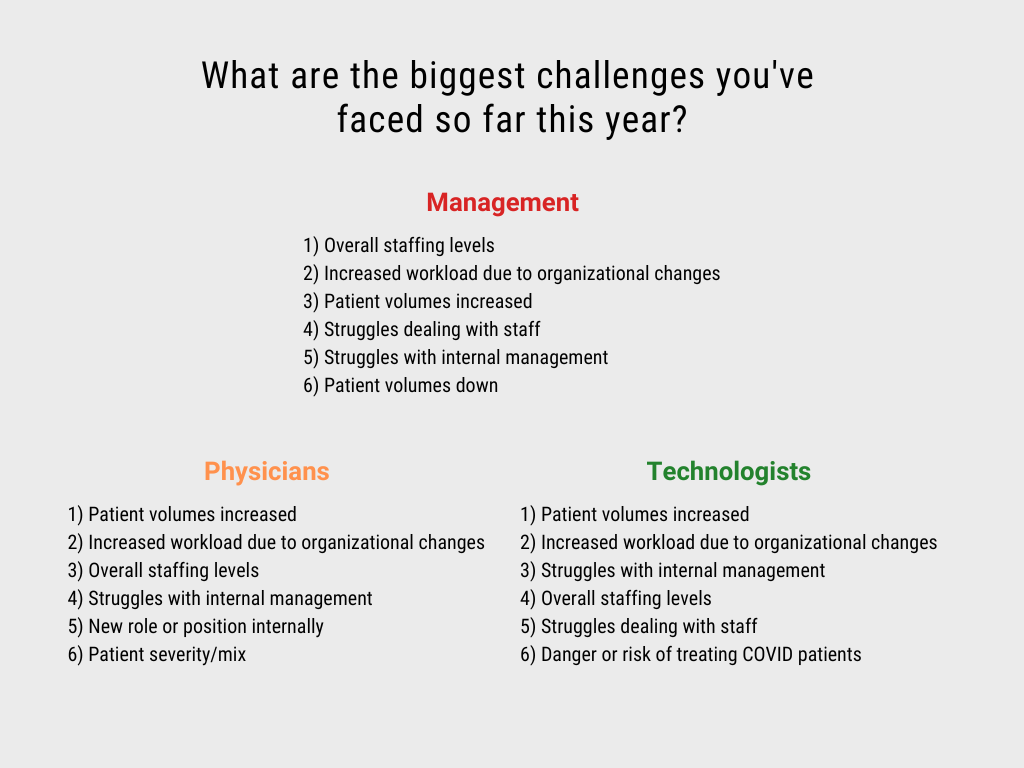
A recent survey from the American Society of Radiologic Technologists highlighted historic vacancy rates in the profession.
All medical imaging disciplines included in the analysis reported their highest percentage of unfilled positions, for which they are actively recruiting, since ASRT started tracking these numbers in 2003. This includes an “all-time high” of 18.1% among radiographers, up from 6.2% in 2021. The findings mirror results from other recent surveys conducted by the American Hospital Association, National Nurses United, and the Hospital and Healthcare Association of Pennsylvania, among others.
Hiring challenges are multifaceted and impacting all levels of the imaging team.

“We are absolutely facing shortages right now, specifically in our larger markets.”
Jennifer Bibles, group president of outpatient imaging services for US Radiology Specialists
“We are absolutely facing shortages right now, specifically in our larger markets,” said Jennifer Bibles, group president of outpatient imaging services for US Radiology Specialists, noting that the challenge has been particularly severe for technologists working with advanced modalities such as MR and CT.
To respond to these challenges, USRS recently announced plans to extend the reach of its Technologist Advancement Academy across all 180 of the practice’s imaging centers in 14 states. The company-sponsored program allows its techs to earn certification in additional imaging modalities, including MR, CT, ultrasound and mammography. Over the past five years, the company has trained 41 X-ray techs in new modalities to expand their skill sets and only four of them have left.
“It speaks to the power of developing people internally and investing in them,” said Dan Balentine, also a group president of outpatient imaging services at US Radiology Specialists. “There’s a much higher success rate in those people staying, and frankly, they are here at lower wages than what is being offered in the marketplace. It’s a strong testament to the power of investing in your people.”
6. Majority are feeling effects of burnout
With rising patient volumes, increased workloads and inadequate staffing levels, burnout levels appear high.
Over the last 12 months, I have felt overworked or burned out on the job:

“Many of us went into radiography because we had a desire to make a difference, to help patients and it also was a good career. You could get an associate’s degree and you had a very stable profession with lots of opportunity for advancement in different areas,” said Melissa Pergola, CEO and executive director of the American Society of Radiologic Technologists. “When considering all of the positives about the profession, I don’t think anybody ever thought that they would be put in a position where they would see what we saw—the devastation during COVID and, quite honestly, putting their lives at risk. Healthcare in general as a profession is suffering because people are pausing for a second before deciding if this is the profession they want to go into.”

“Many of us went into radiography because we had a desire to make a difference, to help patients and it also was a good career."
Melissa Pergola, CEO and Executive Director of the American Society of Radiologic Technologists
Mass General’s Brigham’s Shannon Noelle Wilson said practices are taking preemptive steps to try and limit burnout among radiologists, including banning external moonlighting. She said burnout is just as pervasive on the administrative side of the specialty, with IT one key pain point.
“We just do not have enough people in this space who truly know how to run radiology practices effectively. It’s a huge concern,” she said. “We discuss it all of the time at RBMA: How do we engage emerging leaders within industry? How do we get people excited and want to be in this industry? There is a lot of burnout that no one likes to talk about because they always like to say it’s on the physician side. But when you have to deal with physicians who are burned out, you are 100 times more so than they are.”
7. ‘Making the world a better place’ a top motivator
But what brings joy and meaning to the workplace for professionals who are feeling overwhelmed and burned out? “Know that I am making the world a better place by helping others” was listed as the No. 1 most rewarding part of the job across all titles surveyed. “Being very good at what I do” and “working with a great team/colleagues” also were popular answers.
Here is the breakdown.
The most rewarding parts of my job are (Please choose at least three but no more than five):
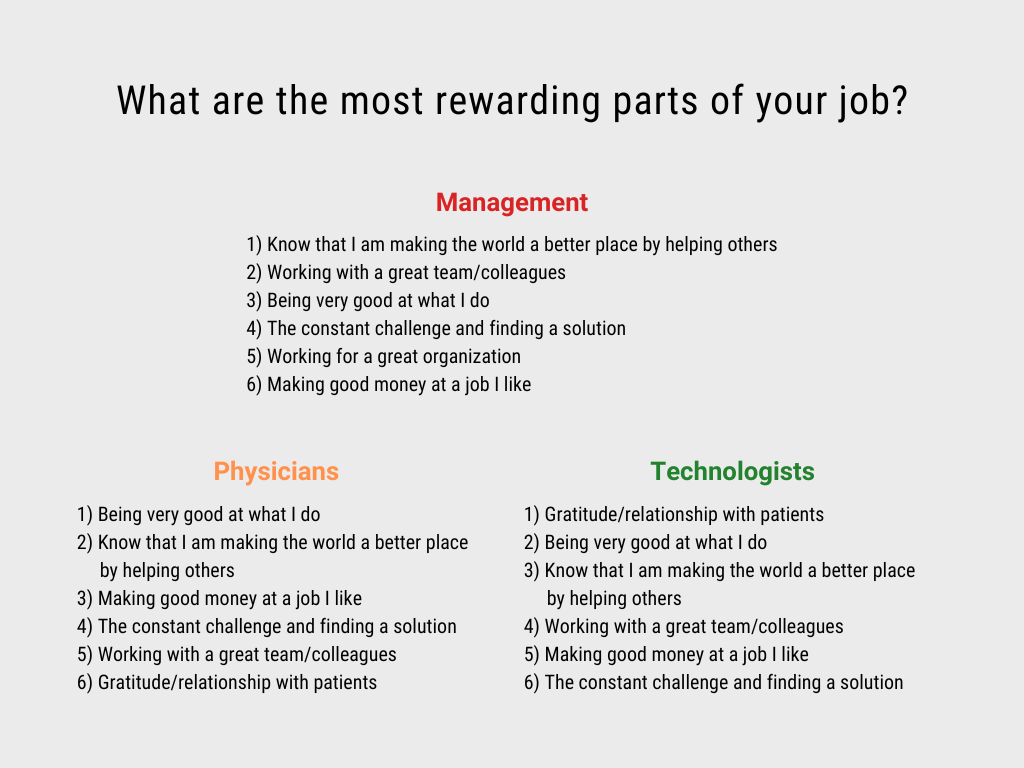
“One of the things that is essential for any leader in any organization is that they are considering what their employees need,” Pergola said. “You want to be that employer of choice where people want to stay or come there to work. There are a lot of ways that we can do that. Some would say it has to do with the amount of money that the technologist is paid. But in my experience as a hospital administrator, that might attract them to you, but to retain an employee, they have to feel valued.”
Additional notes about the 2023 Radiology Business Salary and Job Satisfaction Report
Data for the 2023 Radiology Business Salary and Job Satisfaction Report is based on 2022 compensation. Survey responses were collected from January to March 2023. No outside vendors or associations funded this study. Sources interviewed for this survey only reviewed our data—they did not offer any assistance or funding.

